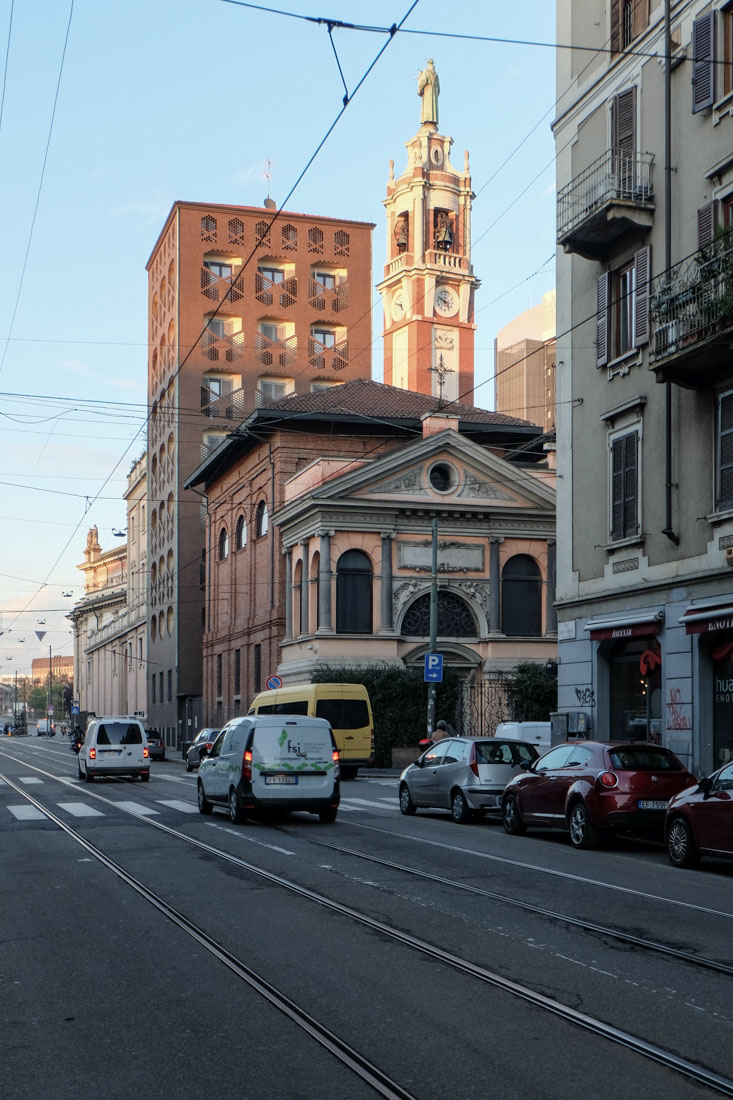 |
 |
 |
 |


Convento Sant Antonio Frati Francescani
Via Carlo Farini 10, Milano
1960 - 1963
From
1960 to 1963 the Sant'Antonio Frati Francescani monastery
was designed by the renowned architect Luigi
Caccia Dominioni. As part of the project the entire
monastery complex was reconstructed, with the exception of
the church and the sacristy. The church and the sacristy
served as reference elements for the design, consisting of
several buildings. These were arranged according to a
complex system of relationships on the property of irregular
shape. The new elements merge with the existing context and
create a harmonious balance between the different buildings.
The most striking element of the design is a tower, which is
connected to the apse of the church and the sacristy above.
This tower on Via Varini, rising above a square plan, is
designed as accommodation for the students of the college.
The arrangement of the tower is particularly motivated by
urban planning. The tower is related to the bell tower of
the monastery and the Lictor tower of a neighboring building
from the fascist era. In addition, there is the main
entrance to the monastery at the base of the tower. An inner
courtyard is created behind the tower, in which Luigi Caccia
Dominioni arranged the cloister. All monks' cells overlook
the central space, which is surrounded by a large portico
made of columns and arches. The massive appearance of the
tower is mitigated by the use of perforated clinker plates.
Behind these finely perforated zones are the balconies and
private areas. The loggias with a light coat of paint stand
in a pleasant color contrast to the dark, hexagonal clinker
plates.
In
den Jahren 1960 bis 1963 entstand das Kloster Sant'Antonio
Frati Francescani nach einem Entwurf des renommierten
Architekten Luigi
Caccia Dominioni. Im Rahmen des Projekts wurde der
gesamte Klosterkomplex, mit Ausnahme der Kirche und der
Sakristei, rekonstruiert. Dabei dienten die Kirche und die
Sakristei als Bezungselemente für den Entwurf. Das Ensemble
besteht aus mehreren Gebäuden. Diese wurden nach einem
komplexen Beziehungssystem auf dem Grundstück von
unregelmässiger Form angeordnet. Dabei verschmelzen die
neuen Elemente mit dem bestehenden Kontext, und erzeugen
eine harmonische Balance der unterschiedlichen Bauwerke. Das
auffälligste Element des Entwurfs ist ein Turm über
quadratischem Grundriss, welcher mit der Apsis der Kirche
und der darüber liegenden Sakristei verbunden ist. Dieser
Turm an der Via Varini ist als Unterkunft für die Studenten
des Kollegiums konzipiert. Die Anordnung des Turms ist
insbesondere städtebaulich motiviert. Der Turm steht in
Beziehung zum Glockenturm des Klosters sowie zum Lictor-Turm
eines benachbarten Bauwerks aus der faschistischen Zeit.
Zudem befindet sich am Fusse des Turms der Hauptzugag des
Klosters. Hinter dem Turm entsteht ein Innenhof, in dem
Luigi Caccia Dominioni den Kreuzgang anordnete. Alle
Mönchszellen blicken auf den zentralen Raum, welcher von
einem grossen Portikus aus Säulen und Bögen gefasst wird.
Die massive Erscheinung des Turms wird durch die Anwendung
perforierter Klinkerplatten gemildert. Hinter diesen fein
perforierte Zonen befinden sich die Balkone und private
Bereiche. Dabei stehen die mit einem hellen Anstrich
versehenen Loggien in einem angenehmen Farbkontrast zu den
dunklen, sechseckigen Klinkerplatten.